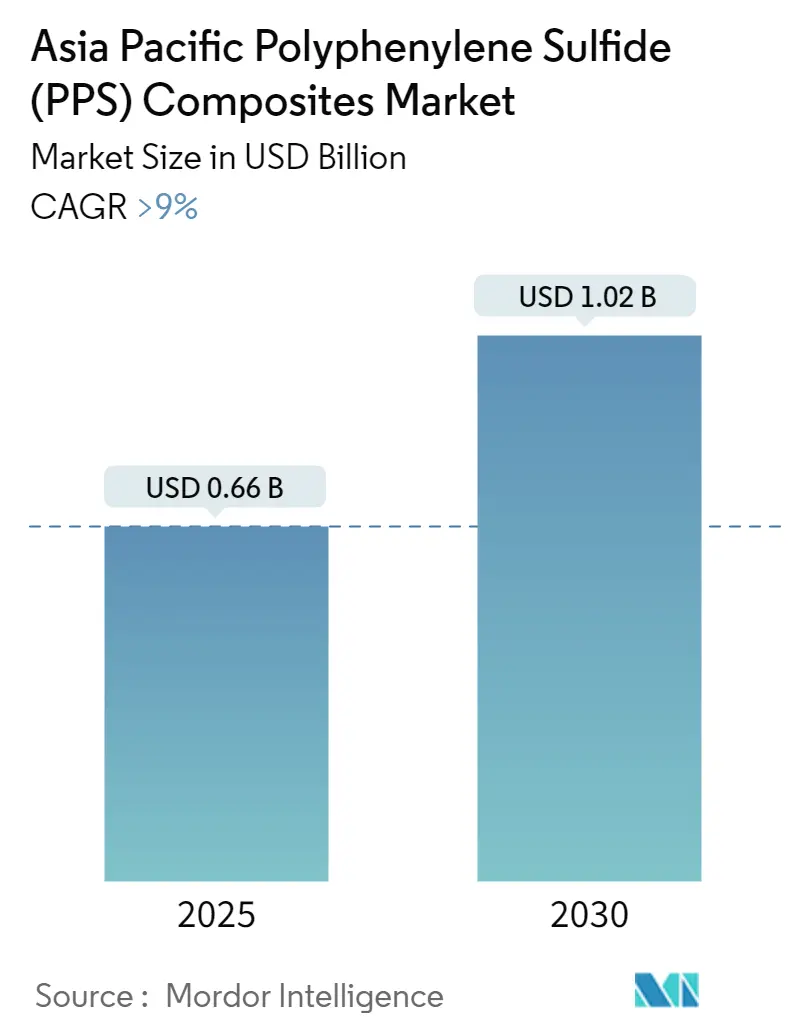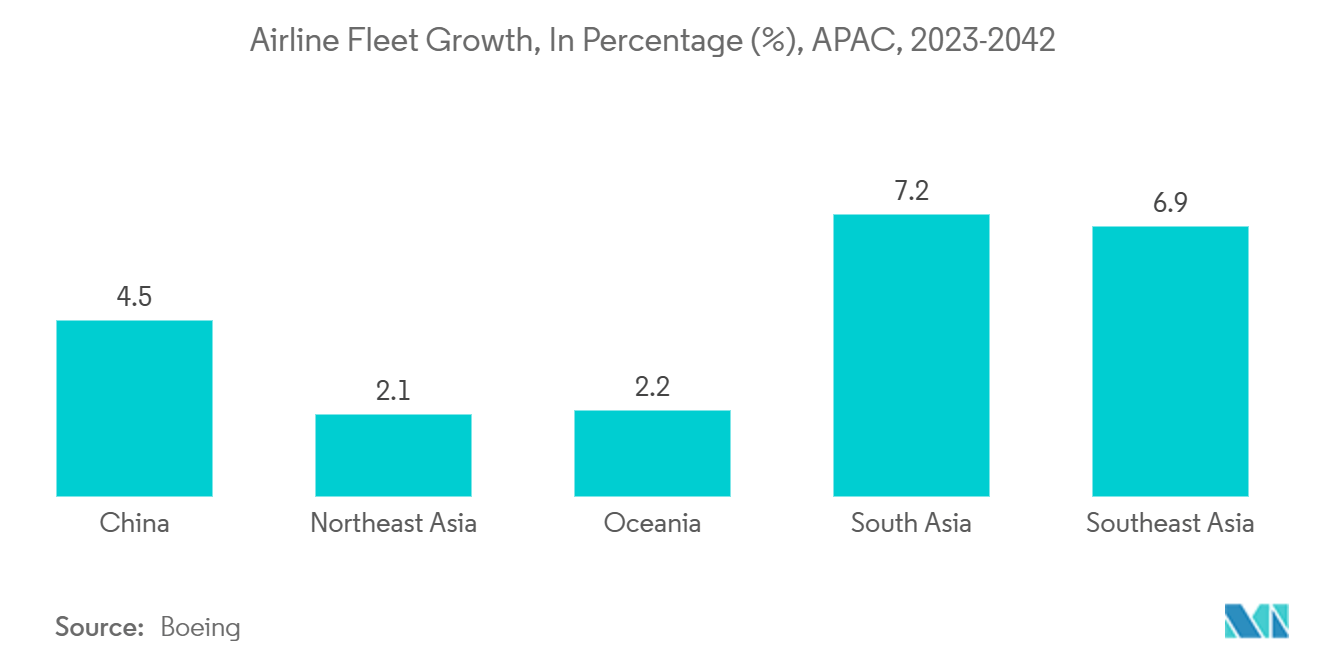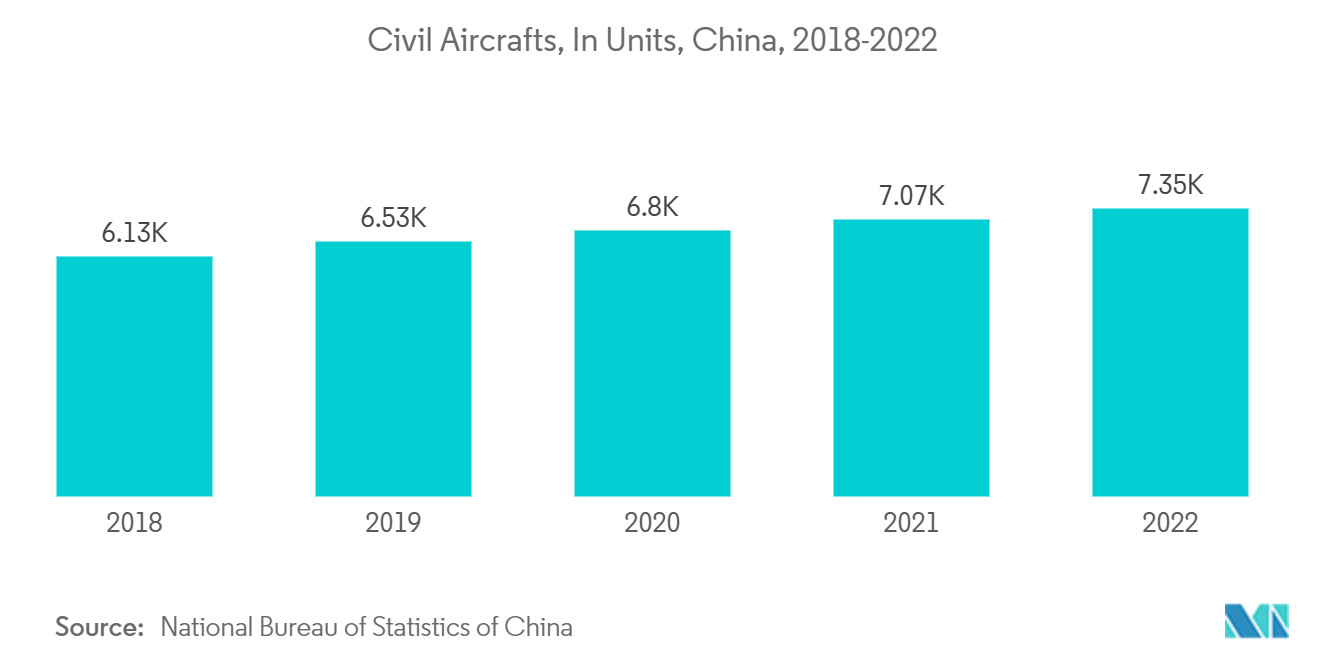Asia-Pacific PPS Composite Market Analysis
The Asia Pacific Polyphenylene Sulfide Composites Market size is estimated at USD 0.66 billion in 2025, and is expected to reach USD 1.02 billion by 2030, at a CAGR of greater than 9% during the forecast period (2025-2030).
The COVID-19 pandemic had a complex and multifaceted impact on the Asia-Pacific Polyphenylene Sulfide (PPS) composites market. While it presented challenges due to supply chain disruptions, demand fluctuations, and economic uncertainty, it also spurred innovation, highlighted new opportunities in healthcare and sustainability, and potentially accelerated the adoption of beneficial technologies in manufacturing. The long-term impact of the pandemic remains to be seen, but the market's adaptability and the ongoing need for high-performance materials like PPS composites suggest a promising future.
- PPS composites offer exceptional strength, heat resistance, and lightweight properties, making them ideal for aircraft components, engine nacelles, and radomes. The growing aerospace industry in Asia, particularly China and India, drives demand for PPS composite materials.
- On the flip side, the processing and manufacturing of PPS composites often involve complex and labor-intensive techniques, driving up costs and may act as a hindrance to the growth of the market studied.
- Implementing automation and digitalization tools in PPS composite production can streamline processes, reduce waste, and improve product consistency, leading to cost savings and increased market penetration. These advancements in the market are expected to aid the market growth opportunities in the future.
- China is expected to be the largest market for polyphenylene sulfide (PPS) composites in the Asia-Pacific region.
Asia-Pacific PPS Composite Market Trends
Aerospace and Defense Sector to Drive the Polyphenylene Sulfide (PPS) Composites Market
- The surge in demand for commercial aircraft is having a significant impact on the aerospace and defense industry, driving growth and innovation in several key areas, such as increased demand for material consumption and material innovation and development.
- Polyphenylene sulfide (PPS) composites are widely used in the aerospace and defense industry, as they exhibit a combination of high-temperature performance, creep resistance, excellent dimensional stability, chemical resistance, and flame resistance. Along with other properties, it makes it suitable for interior applications, such as high-temperature ducting, seat frames, and interior panels.
- The manufacturers are focusing on solutions to meet the need to reduce weight and increase fuel efficiency. The materials used in commercial aircraft include aluminum alloys, steel alloys, titanium alloys, and composite materials.
- China's defense industry is increasing, with many Chinese firms displacing Western defense powerhouses. The country invests heavily to upgrade its military, thus making its eight defense firms among the top 25 in the world.
- In June 2021, Indonesia unveiled another plan to spend USD 125 billion through the mid-2040s to upgrade and modernize its military arsenal. The total period runs through a period of five strategic plans, each lasting five years. The first strategic plan runs from 2020 to 2024 and coincides with the final phase of the Minimum Essential Force (MEF) program. The document proposes funding of USD 79 billion for defense equipment during these 25 years, USD 32.5 billion for sustainment, and the remaining USD 13.4 billion for interest payments on foreign loans.
- In Japan, an increase in defense expenditure, rising procurement of next-generation weapons, and adoption of advanced technologies in military communication are driving the growth of the market across Japan. According to the report published by the Stockholm International Peace Research Institute (SIPRI) in 2022, Japan was the tenth largest defense spender in the world, with a defense budget of USD 46 billion. The country approved USD 51.4 billion in defense spending in FY2023.
- In March 2023, Japan Airlines (JAL), Japan's national flag carrier, announced an order of 21 Boeing B737 MAX aircraft. The airline aims to bring advanced and fuel-efficient aircraft into its fleet starting in 2026. The value of the contract was approximately USD 2.5 billion. Haneda International Airport (HND), Narita International Airport (NRT), Kansai International Airport (KIX), and Fukoma International Airport (FUK) are the four major airports in Japan that together handle over 200 million passengers annually. Furthermore, Japanese companies are also actively engaged in providing engineering services towards the development and MRO of aircraft engines, such as the V2500, Trent1000, GEnx, GE9X, PW1100G-JM, etc.
- In March 2022, Singapore disclosed its new procurement plans in pursuit of the SAF 2040 vision. This plan includes several procurements and upgrade programs that the country undertook or will undertake in the coming years. As part of this, the country will also be establishing a fourth service branch for the Singapore Armed Forces (SAF) to defend the country against threats in the digital domain.
- All the factors above are expected to drive the polyphenylene sulfide (PPS) composites market in the region during the forecast period.
China to the Dominate the Asia-Pacific Region
- China is the largest economy in terms of GDP. The IMF (International Monetary Fund) projects a GDP growth of 5% for the country in 2023.
- According to CAAC (Civil Aviation Administration of China), China plans to expand domestic flights and restore international air travel from 2023 to 2025. Given that post-COVID passenger travel is expected to return, the CAAC continues to construct new airports, with an expected total of 270 by 2025.
- The oil and gas industry is one of the key contributors to the Chinese economy. The oil and gas industry operates in high-temperature environments.
- According to BP Statistical Review 2023, the overall oil production in the country reached 204.7 million metric tons in 2022 at a growth rate of 2.9% compared to 198.9 million metric tons produced in 2021.
- Similarly, the country's overall oil consumption is on the rise over the past decade. For instance, in 2022, the country's oil consumption in thousands of barrels per day was 14,295 thousand barrels per day, whereas in 2021, the consumption stood at 14,893 thousand barrels per day. In addition, the consumption growth rate is 3.6% yearly over the decade between 2012 and 22.
- Additionally, China's appetite for aviation seems set to grow exponentially. High demand for aviation led to the government's decision to introduce airport-building programs, which include massive investment in terminals and runways.
- Currently, the annual output of Chinese military aircraft is around 300. As China's military industry continues to grow, the demand for and supply of Chinese military aircraft will increase substantially. It will drive the rapid development of China's military aircraft manufacturing industry.
- Asia is the largest automotive manufacturing hub in the world. The development of electric vehicles is expected to continue to gain momentum in the future, especially in China. Here, many government programs are promoting the move away from fossil fuels, owing to various environmental concerns.
- The Chinese automotive manufacturing industry is the largest in the world. However, the industry witnessed a slowdown in recent years, wherein production and sales declined. According to the China Association of Automobile Manufacturers (CAAM), automotive sales in China fell by 8.4% yoy to 2.56 million units in December 2022, whereas, for the full year 2022, the sales grew to 26.86 million units.
- Furthermore, China holds the world's most extensive production base for electronics. Electronic products, such as smartphones, OLED TVs, tablets, wires, cables, and earphones, are recording the highest growth in electronics.
- All the factors mentioned above are anticipated to propel the polyphenylene sulfide (PPS) composites market in the country during the forecast timeframe.
Asia-Pacific PPS Composite Industry Overview
The Asia-Pacific polyphenylene sulfide (PPS) composites market is partially consolidated in nature. The major players (not in any particular order) include DIC Corporation, SABIC, Teijin Limited, Celanese Corporation, and Solvay, among others.
Asia-Pacific PPS Composite Market Leaders
-
DIC Corporation
-
SABIC
-
TEIJIN LIMITED
-
Solvay
-
Celanese Corporation
- *Disclaimer: Major Players sorted in no particular order
Asia-Pacific PPS Composite Market News
- November 2022: Polyplastics Co., Ltd. expanded its compound capacity of (Nantong) Ltd., the PPS resin production plant. The newly expanded capacity will meet the demand for engineering plastics worldwide and increase the annual production capacity from 9,000 to 21,400 tons. The new manufacturing plant will be in operation from January 2025.
- April 2022: SABIC, a global leader in the chemical industry, launched a glass fiber-reinforced material based on polyphenylene sulfide (PPS) resin, LNP THERMOCOMP OFC08V compound. The material suits 5G base station dipole antennas and other electrical and electronic applications.
Asia-Pacific PPS Composite Industry Segmentation
Polyphenylene sulfide (PPS) is a semi-crystalline thermoplastic that consists of multiple aromatic rings of p-substituted benzene and sulfur. It is widely used in felt filter media for high-temperature air filters, coil formers, bobbins, slurry coatings, terminal blocks, relay components, specialty membranes, and packaging. PPS exhibits various advantageous properties, such as high chemical and abrasion resistance, dimensional stability, and mechanical strength. It is also lightweight and includes a high melting point and low viscosity index that assists it in being molded into the desired shapes. As a result, PPS finds extensive application across various industries, such as aerospace, medical, automotive, electrical, and electronics.
The Asia-Pacific polyphenylene sulfide (PPS) composites market is segmented by type, end-user industry, and geography. By type, the market is segmented into carbon fiber-reinforced composites, glass fiber-reinforced composites, and other types (mineral-filled PPs, nanocomposite PPs, and continuous fiber PPS). By end-user industry, the market is segmented into aerospace and defense, automotive, oil and gas, electrical and electronics, industrial, and other end-user industries (medical, marine, sporting goods, etc.). The report also covers the market size and forecasts for the Asia-Pacific polyphenylene sulfide market for 5 major countries across the major regions. For each segment, the market sizing and forecasts are done on the basis of value (USD).
| Type | Carbon Fiber-Reinforced Composites |
| Glass Fiber-Reinforced Composites | |
| Other Types (Mineral-Filled PPS, Nanocomposite PPS, and Continuous Fiber PPS) | |
| End-user Industry | Aerospace and Defense |
| Automotive | |
| Oil and Gas | |
| Electrical and Electronics | |
| Industrial | |
| Other End-user Industries (Medical, Marine, Sporting goods, etc.) | |
| Geography | China |
| India | |
| Japan | |
| South Korea | |
| ASEAN Countries | |
| Rest of Asia-Pacific |
Asia-Pacific PPS Composite Market Research FAQs
How big is the Asia Pacific Polyphenylene Sulfide Composites Market?
The Asia Pacific Polyphenylene Sulfide Composites Market size is expected to reach USD 0.66 billion in 2025 and grow at a CAGR of greater than 9% to reach USD 1.02 billion by 2030.
What is the current Asia Pacific Polyphenylene Sulfide Composites Market size?
In 2025, the Asia Pacific Polyphenylene Sulfide Composites Market size is expected to reach USD 0.66 billion.
Who are the key players in Asia Pacific Polyphenylene Sulfide Composites Market?
DIC Corporation, SABIC, TEIJIN LIMITED, Solvay and Celanese Corporation are the major companies operating in the Asia Pacific Polyphenylene Sulfide Composites Market.
What years does this Asia Pacific Polyphenylene Sulfide Composites Market cover, and what was the market size in 2024?
In 2024, the Asia Pacific Polyphenylene Sulfide Composites Market size was estimated at USD 0.60 billion. The report covers the Asia Pacific Polyphenylene Sulfide Composites Market historical market size for years: 2019, 2020, 2021, 2022, 2023 and 2024. The report also forecasts the Asia Pacific Polyphenylene Sulfide Composites Market size for years: 2025, 2026, 2027, 2028, 2029 and 2030.
Our Best Selling Reports
APAC Polyphenylene Sulfide (PPS) Composites Industry Report
Statistics for the 2025 Asia Pacific Polyphenylene Sulfide (PPS) Composites market share, size and revenue growth rate, created by Mordor Intelligence™ Industry Reports. Asia Pacific Polyphenylene Sulfide (PPS) Composites analysis includes a market forecast outlook for 2025 to 2030 and historical overview. Get a sample of this industry analysis as a free report PDF download.

_Composites_Market_-_Key_Players.webp)



_Composites_Market__-_Market_Concentration.webp)

